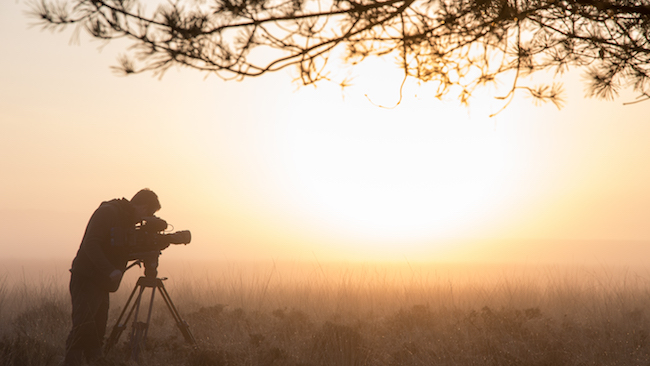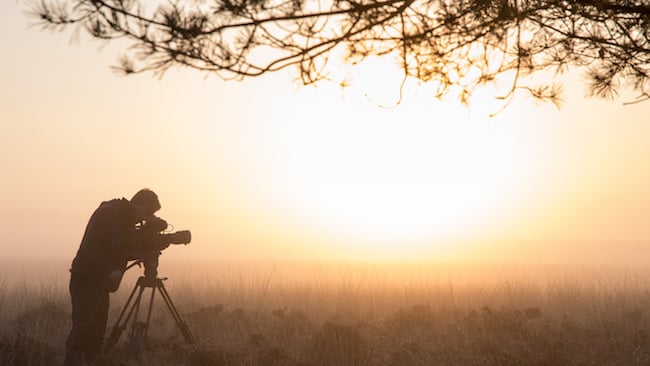
 Wildlife photographer Dick Harrewijn on location with the VariCam
Wildlife photographer Dick Harrewijn on location with the VariCam
With a dual native ISO, 14+ stops of dynamic range and enhanced colour rendition, the new generation of Varicams have remarkable and unique talents.
Wildlife photographer, Dick Harrewijn: “As a one man band, there are many moments where time forces me to work quickly and I might find myself in a situation without gradient filters at close hand. No problem!”
Panasonic’s VariCam has a long and illustrious history. When Planet Earth - the original one - first aired on the BBC in 2007 it was acclaimed for the quality of the wildlife footage. Shot mainly with the first generation VariCam, the images were astonishing. Viewed on today’s far superior displays, the material still looks fresh, colourful and sharp.
Fast forward to 2017 and the latest generation of VariCams, designed with cinema, TV drama and all genres of high-quality filmmaking in mind, is capable of vivid, high-resolution images, in 4k HDR.
The VariCam 35 and VariCam LT have a remarkable ability to shoot with two native ISOs: 800 and 5000. This makes them uniquely flexible. Let’s have a closer look at what this means in practice.
Dual ISO
Dual native ISO means exactly that: there are two optimal settings for the camera. The native ISO of a camera is the sensitivity that gives the best images. Any other setting means applying gain, which amplifies the noise floor. Ideally, you should always use a camera at its native ISO.
VariCam’s 5000 ISO completely transforms the process of filmmaking. There’s less need for huge and expensive lighting rigs. Shooting becomes (and looks!) spontaneous and free. Shooting in natural light opens up new creative options. City scenes at night explode with colour. Dawn and dusk shimmer with a newly-found luminosity. In very low light, you might imagine it would look like monochromatic night-vision, but it doesn’t. Instead, you see a full spectrum of colour.
There are other benefits too. With fewer lights needed, shooting becomes more affordable. Not only is the lighting budget smaller, but without the heat generated by banks of HMIs, there’s less need for expensive air conditioning on-set.
In practice, the camera’s sensitivity is transformative. This is what Stephan Pehrsson, Director of Photography on the BBC’s Docu-Drama “The Moorside” said about using the VariCam on the shoot:
“Our mission was to be as invisible as possible, to allow that cinéma vérité feel. Because we weren’t spending so much time resetting lights, we could spend more time shooting and getting better performances from a brilliant cast. We were shooting each setup 7 or 8 times as we were able to turn around on the location so quickly. I pity the DIT who had to deal with such a massive amount of material.”
He went on to say:
"The Line Producer loved it, the economic saving from having such limited lighting on set allowed us to bring in more extras, which just enhanced the show,” added Stephan Pehrsson.
"Keeping it small meant that we were also able to have a much lower profile. In actual fact, we had such a minimal lighting set-up that Jeff Pope, the Executive Producer, came on set and couldn't find us. Normally you can't miss a drama crew.”
HDR
HDR is being adopted faster than almost any advance in video technology before it. It’s easy to see why: it clearly makes the picture look better, and the difference is obvious - even to non-technical viewers. Anything above 10 stops of Dynamic Range is considered to be suitable for HDR, but with the VariCam’s 14+ stops, directors and DOPs have all the latitude they need: enough for experimentation and plenty to make virtually any shot safe from clipping or underexposure. Such a wide Dynamic Range also gives more options to post production to grade the content all the way from SDR to HDR and to “push” the material freely to bring out a certain look.
Exceptional colour
The VariCam’s custom-designed sensor has Panasonic’s “V-Gamut” technology for a wider colour gamut than film for exceptional colour imaging. Panasonic goes to extraordinary measures in the in-house design and the fabrication of the VariCam imager, the Bayer processing and V-Gamut colour science, which results in amazing deep and rich colour imaging.
With 14+ stops of Dynamic Range, incredible colour fidelity, and the ability to shoot natively in very low light, Panasonic’s VariCams are changing the way that content for TV and films is created. It’s ready for the future, lowers production costs and opens up new and exciting creative possibilities.
To learn more about the VariCam 4K cinema camera family, visit (U.S.) and (Europe).
Tags: Production


Comments